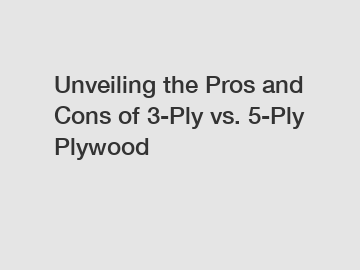Unveiling the Pros and Cons of 3-Ply vs. 5-Ply Plywood
Unveiling the Pros and Cons of 3-Ply vs. 5-Ply Plywood?
When it comes to choosing the right plywood for your construction or woodworking projects, the options can be overwhelming. Plywood is a versatile and popular building material known for its strength and durability. Two common types of plywood that you'll often come across are 3-ply and 5-ply plywood. But what are the pros and cons of each? Let's delve into this question further.
First, let's understand the basic difference between 3-ply and 5-ply plywood. The term "ply" refers to the layers of wood veneer that make up the plywood. As the names suggest, 3-ply plywood consists of three layers of wood veneer, while 5-ply plywood has five layers. These layers are glued together to create a strong and sturdy panel.

Now, let's examine the pros and cons of each type of plywood to help you make an informed decision:
3-Ply Plywood:
Pros:
1. Cost-effective: 3-ply plywood is generally cheaper than 5-ply plywood. If you're on a tight budget, this type of plywood can be a more affordable option for your projects.
2. Lightweight: Due to its fewer layers, 3-ply plywood is lighter in weight compared to 5-ply plywood. This makes it easier to handle and transport, especially for DIY enthusiasts and smaller projects.
3. Flexibility: 3-ply plywood has a bit more flexibility compared to its 5-ply counterpart. This flexibility can be advantageous when working on curved or irregular surfaces, providing greater adaptability.
Cons:
1. Reduced strength: With fewer layers, 3-ply plywood may not have the same level of strength as 5-ply plywood. It may be more prone to warping or sagging under heavy loads or in adverse conditions. Thus, for structural applications or projects requiring high durability, 3-ply plywood may not be the ideal choice.
5-Ply Plywood:
Pros:
1. Increased strength and stability: The additional layers in 5-ply plywood make it stronger and more stable, offering enhanced performance for larger and more demanding projects. It can withstand heavier loads and is less likely to warp or deform over time.
2. Better structural support: 5-ply plywood provides excellent structural support, making it suitable for applications like flooring, roofing, and furniture construction. Its superior strength ensures long-lasting durability, reducing the need for repairs or replacements.
3. Enhanced resistance: The additional layers in 5-ply plywood offer better resistance to moisture, humidity, and temperature changes. This makes it ideal for outdoor projects or areas with high moisture content, such as bathrooms and kitchens.
Cons:
1. Higher cost: Compared to 3-ply plywood, 5-ply plywood is generally more expensive. If budget is a constraint, you might need to weigh the benefits against the higher price.
2. Heavier weight: Due to the additional layers, 5-ply plywood is heavier than 3-ply plywood. This can make it more challenging to handle and transport, especially for large-scale projects.
3. Limited flexibility: As 5-ply plywood is stiffer and less flexible, it may not be the best choice for projects requiring curved or irregular shapes. Its rigidity can make it more challenging to work with in such applications.
In conclusion, the choice between 3-ply and 5-ply plywood ultimately depends on your specific project requirements, budget, and preferences. If you're looking for an economical and lightweight option for smaller projects, 3-ply plywood may be the way to go. However, if strength, stability, and resistance to moisture are crucial factors, 5-ply plywood would be a better choice, albeit at a higher cost and weight.
Always consider the intended use, environmental conditions, and budget constraints before making a decision. By understanding the pros and cons of both 3-ply and 5-ply plywood, you can confidently select the right option for your construction or woodworking needs.
If you are looking for more details, kindly visit wholesale stainless steel flatware, stainless steel cookware manufacturer, stainless steel cookware suppliers.


